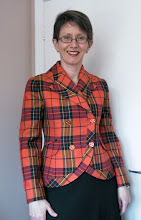DIGS slyly asked me how my dress is coming along. Well, as you can probably guess, my dress is still in flat folds on my sewing table! However, I've been doing some mental sewing which is all part of the project prep, don't you agree?
In this case, part of the mental prep is coming to terms with the fact that if the evidence is confronted, by the time I can finish the dress, the just-finished bouclé jacket will be far too heavy to actually wear with it. So I dug into stash to see if I had a lighter-weight jackety fabric to go with the turquoise wool crepe, and I do. Surprise! It's a nubbly, multicolour raw silk tweed. Not only that, the china silk fabric I had earmarked for lining the bodice of the dress looks kind of nice with the tweed. So the dress could be next in the sewing line-up. I'll let you know.
But in the meantime I started another pair of socks, toe up this time. One down, one to go.
Ahem. I'll take another sewing question. In response to the post about ripping out sleeves and matching plaid, Lena Merrin asked: "Just curious, your sleeve still has ease even though the fabric stripes are matching, right?" I suspect you asked because of Kathleen Fasanella's famous post, Sleeve Cap Ease is Bogus. It's a very thought provoking article but you can match the plaid in a sleeve cap to the jacket body, front and back, even if the sleeve cap seam line is longer than the seam line of the armscye (i.e. even if there is some ease in the sleeve cap). My jacket is the living proof, but here's my take on the geometry.
This is a quick and dirty draft from PMB with some pretend plaid drawn on top. The program drafted a total of 2cm of ease in the front of the sleeve cap. Because the armscye seam is more vertical than the sleeve cap seams, the distance between the plaid lines where they hit the seam line on the sleeve cap is greater than the distance between the same lines where they hit the seam line of the armscye. When you ease in that extra distance the plaid lines can be made to match (more or less).
Clear as mud?
Clear as mud?


.jpg)



I was at Indigo today and picked up the Pattern Review book. Flipped to a page and saw your name mentioned there!
ReplyDeleteI looked closely at your graphic and I noticed that the CF notch doesn't match up and this is the point that I typically used to match with mixed results. At what point do you focus on matching the pattern? Is it the under arm point?
ReplyDeleteI read Kathleen Fasanella article too and struggled with the concept as I have always added ease into the sleeve cap especially in jackets and still managed to match the plaids at the most significant points. Interestingly, Susan Khalje recommends over an inch of ease in sleeve caps in her video course The Couture Dress on craftsy.com. Seeing there are such different points of view from 2 well respected experts, I would actually assume that the truth lies somewhere in the middle. Personally I would always put ease into jackets and coats as well as tighter fitting garments and less to none on wider garments out of thinner fabrics. For instance I don't think T-shirts or men's shirts need ease. If I want plaid to match on sleeves, I generally would not cut them out until the body of the garment was sewn up, then cut a sleeve out of muslin and baste it in. Once I was 100% sure of the sleeve fit, I would draw the main plaid lines on to the muslin sleeve and use that as a pattern. sometime I would even cut the sleeve slightly off grain (a major sin normally) but I feel that matching plaid, front and back if possible, is more important than straight grain lines on sleeves!
ReplyDeleteI asked Kenneth King about matching plaid when there is ease in the sleeve cap and also says that you can match it up, front and back. The thing about not having ease is that you don't have room for that nice lift in the cap. That's fine in a blouse but not so good in a jacket or coat imop.
ReplyDeleteYes, I see that the difference in angles makes for a longer linear length between plaid lines, 15% or so in this case, allowing for ease while still matching up lines. Fantastic analysis! I went to the Fasanella post, and found that, while its discussion is beyond my skills, it appears to be primarily about the difference between patterns drafted for a sewist who will make one garment, and patterns honed for a factory turning out thousands. There is much more, of course, but I believe the Big 4 presume basic knowledge, no more, and thus a market-based mandate to keep it simple. Regardless, I loved your explanation of How you were able to achieve success.
ReplyDeleteHi - I admire you for matching the plaids on sleeves. (I still struggle getting a sleeve sew in right, even when there are no plaids to worry about.)
ReplyDeleteJust wondering how do you like the PMB software? I wear a lot of knits, & I'm thinking of investing in their PatternMaster Knits software. Do you happen to know if the PatternMaster Boutique software already includes Knits?
:-)